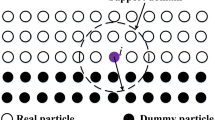Abstract
The dynamic response of deformable structures subjected to shock load and cavitation reload has been simulated using a multiphase model, which consists of an interface capturing method and a one-fluid cavitation model. Fluid–structure interaction (FSI) is captured via a modified ghost fluid method (Liu et al. in J Comput Phys 190: 651–681, 2003), where the structure is assumed to be a hydro-elasto-plastic material if subjected to a strong shock load. Bulk cavitation near the structural surface is captured using an isentropic model (Liu et al. in J Comput Phys 201:80–108, 2004). The integrated multiphase model is validated by comparing numerical predictions with 1D analytical solutions, and with numerical solutions calculated using the cavitation acoustic finite element (CAFÉ) method (Sprague and Geers in Shocks vib 7:105–122, 2001). To assess the ability of the multiphase model for multi- dimensions, underwater explosions (UNDEX) near structures are computed. The importance of cavitation reloading and FSI is investigated. Comparisons of the predicted pressure time histories with different explosion center are shown, and the effect on the structure is discussed.
Similar content being viewed by others
References
Bleich HH, Sandler IS (1970) Interaction between structures and bilinear fluids. Int J Solids Struct 6:617–639
Deshpande VS, Fleck NA (2005) One-dimensional shock response of sandwich beams. J Mech Phys Solids 53:2347
Farhat C, Roux FX (1991) A method for finite element tearing and interconnecting and its parallel solution algorithm. Int J Numer Meth Eng. 32:1205–1227
Fedkiw RP (2002) Coupling an Eulerian fluid calculation to a Lagrangian solid calculation with the Ghost fluid method. J Comput Phys 175:200–224
Fedkiw RP, Marquina A, Merriman B (1999) A non oscillatory eulerian approach to interfaces in multimaterial flows (The ghost fluid method). J Comput Phys 152:457–492
Harten A (1984) On a class of high resolution total variation stable finite difference Schemes. SIAM J Numer Anal 21: 1–23
Harten A, Osher S (1987) Uniformly high-order accurate non-oscillatory schemes I. SIAM J Numer Anal 24:279–309
Harten A, Lax PD, Van Leer B (1983) Upstream differencing and Godunov-type schemes for hyperbolic conservation laws. SIAM Rev 25:35–61
Huang H (1979) Transient response of two fluid-coupled spherical elastic shells to an incident pressure pulse. J Acoust Soc Am 65(4):881–887
Huang H, Wang YF (1970) Transient interaction of spherical acoustic waves and a cylindrical elastic shell. J Acoust Soc Am 48(1):228–235
Hughes TJR, Tezduyar TE (1984) Finite element method for first-order hyperbolic systems with particular emphasis on the compressible Euler equations. Comput Methods Appl Mech Eng 45:217–284
Hutchinson JW, Xue Z (2005) Metal sandwich plate optimized for pressure impulses. Int J Mech Sci 47:545–569
Johnson AA, Tezduyar TE (1994) Mesh update strategies in parallel finite element computations of flow problems with moving boundaries and interfaces. Comput Methods Appl Mech Eng 119:73–94
Johnson AA, Tezduyar TE (1999) Advanced mesh generation and update methods for 3D flow simulations. Comput Mech 23:130–143
Liu TG, Khoo BC, Yeo KS (2003) Ghost fluid method for strong shock impacting on material interface. J Comput Phys 190:651–681
Liu TG, Khoo BC, Xie WF (2004) Isentropic one-fluid modelling of unsteady cavitating flow. J Comput Phys 201:80–108
Osher S, Sethian JA (1988) Fronts propagating with curvature dependent speed. Algorithms based on Hamilton–Jacobi formulations. J Comput Phys 79:12–49
Schmidt DP, Rutland CJ, Corradini ML (1999) A fully compressible, two-dimensional model of small, high speed, cavitating nozzles. At Sprays 9:255–276
Shu CW, Osher S (1988) Efficient implementation of essentially nonoscillatory shock-capturing schemes. J. Comput Phys 77:439–471
Sprague MA, Geers TL (2001) Computational treatments of cavitation effects in near-free-surface underwater shock analysis. Shock Vib 7:105–122
Sprague MA, Geers TL (2003) Spectral elements and field separation for an acoustic fluid subject to cavitation. J Comput Phys 184:149–162
Stein K, Tezduyar TE, Benney R (2003) Mesh moving techniques for fluid–structure interactions with large displacements. J Appl Mech 70:58–63
Tang HS, Sotiropoulos F (1999) A second-order Godunov method for wave problems in coupled solid–water–gas systems. J Comput Phys 151:790–815
Taylor GI (1941) The pressure and impulse of submarine explosion waves on plates. The scientific papers of G I Taylor, vol III, p 287–303. Cambridge University Press, Cambridge
Tezduyar TE (2003) Computation of moving boundaries and interfaces and stabilization parameters. Int J Numer Meth Fluids 43:555–575
Tezduyar TE, Senga M (2005) SUPG finite element computation of inviscid supersonic flows with YZ· shock-capturing. Comput Fluids (in press)
Tezduyar TE, Senga M, Vicker D (2006) Computation of inviscid supersonic flows around cylinders and spheres with the SUPG formulations and YZβ shock-capturing. Comput Mech 38:469–481
Van Leer B (1974) Towards the ultimate conservative difference schemes II: Monotonicity and conservative combined in a second-order scheme. J Comput Phys 14:361–370
Van Leer B (1977) Towards the ultimate conservative difference schemes III: Upstream centred finite-difference schemes for ideal compressible flow. J Comput Phys 23:263–275
Wardlaw AB, Luton JA (2000) Fluid–structure interaction mechanisms for close-in explosions. Shock Vib 7:265–275
Wardlaw AB, Mair HU (1998) Spherical solutions of an underwater explosion bubble. Shock Vib 5:89–102
Xie WF, Liu TG, Khoo BC (2006) Application of a one-fluid model for large scale homogeneous unsteady cavitation: the modified Schmidt model. Comput Fluids 35:1177–1192
Author information
Authors and Affiliations
Corresponding author
Rights and permissions
About this article
Cite this article
Xie, W.F., Young, Y.L., Liu, T.G. et al. Dynamic response of deformable structures subjected to shock load and cavitation reload. Comput Mech 40, 667–681 (2007). https://doi.org/10.1007/s00466-006-0132-z
Received:
Accepted:
Published:
Issue Date:
DOI: https://doi.org/10.1007/s00466-006-0132-z




